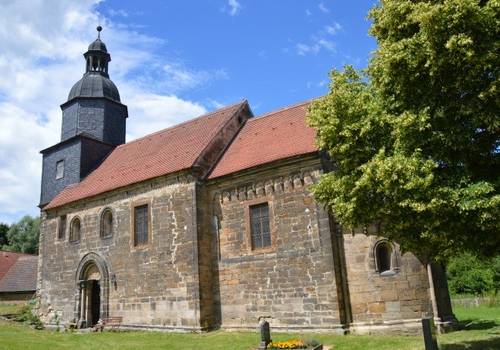Church of St. Margaret, Steinbach
Located between Bad Bibra and Steinbach, today, the church has lost its village, which in itself lends it a special aura. Built in around 1220, St. Margaret’s church is a treasure of Romanesque architecture. The construction of such a church, which is unusual in a small village, can only be explained by the influence of the Augustinian monastery. It was probably built by master craftsmen of Naumburg. Like Naumburg cathedral, it features many decorative forms typical of the late Romanesque period. The village of Steinbach itself was first recorded in 952. The old Steinbach is understood to have been located in the area around where the church stands today, and was probably completely destroyed in the Thirty Years War. It has since been rebuilt in its current location. No village remains have been discovered in the vicinity of the church to date.
The late-Romanesque complex exhibits a typical staggered structure: a square west tower, a rectangular nave and a choir to the east, adjoined by the apse. The tower was certainly added later on, complemented with Baroque features, and partially cladded in slate. The round-arched and richly structured columned portal is particularly skilfully designed, with beautiful capitals bearing plant motifs, and the remains of an eagle and a tympanum (arched area) above the door. Arched friezes in the choir and apse, with a variety of corbels, a stepped frieze on the choir gable, and the jamb embrasures on the original window, are striking. One marvels at the small squared-stone masonry, with such a wealth of charming stone carvings. Inside the church the massive arches of the choir and the apse impress. Then, one discovers the richly ornate capitals, featuring plant ornamentation and a face, on the corner pillars of the choir. Behind these pillars, and also through the unevenness of the plastered walls on the sides of the choir, one can trace the outlines of an original cross vault. Today, the choir has a flat wooden ceiling, as was indeed common in the Romanesque period.
Nevertheless, the church raises many questions when looked at, and despite research into its construction, it still holds many a secret. Where is the village that once belonged to the church? Who commissioned the elaborate ornamentation, normally reserved for major cathedrals or monastery churches? We hope that the church will long be preserved for future generations, and that many a secret can still be revealed.
Opening hours: open church on weekends from May to October
Admission Fee: none, donations invited. Guided tours on request

![25 Jahre Siegel - Offi Seite [(c)Administrator]](https://www.strassederromanik.de/de/datei/anzeigen/id/79750,1050/25_jahre_siegel.png)

